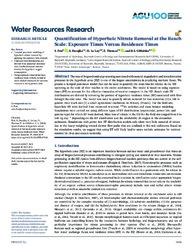Quantification of Hyporheic Nitrate Removal at the Reach Scale: Exposure Times Versus Residence Times
DOI: https://doi.org/10.1029/2019WR025540
Persistent URL: http://resolver.sub.uni-goettingen.de/purl?gldocs-11858/9024
Persistent URL: http://resolver.sub.uni-goettingen.de/purl?gldocs-11858/9024
Frei, S.; Durejka, S.; Le Lay, H.; Thomas, Z.; Gilfedder, B.S., 2019: Quantification of Hyporheic Nitrate Removal at the Reach Scale: Exposure Times Versus Residence Times. In: Water Resources Research, Band 55, 11: 9808 - 9825, DOI: 10.1029/2019WR025540.
 |
Dokument öffnen: |
The rate of biogeochemical processing associated with natural degradation and transformation processes in the hyporheic zone (HZ) is one of the largest uncertainties in predicting nutrient fluxes. We present a lumped parameter model that can be used to quantify the mass loss for nitrate in the HZ operating at the scale of river reaches to the entire catchments. The model is based on using exposure times (ET) to account for the effective timescales of reactive transport in the HZ. Reach scale ET distributions are derived by removing the portion of hyporheic residence times (RT) associated with flow through the oxic zone. The model was used to quantify nitrate removal for two scenarios: (1) a 100 m generic river reach and (2) a small agricultural catchment in Brittany (France). For the field site, hyporheic RT were derived from measured in-stream 222Rn activities and mass balance modeling. Simulations were carried out using different types of RT distributions (exponential, power law, and gamma-type) for which ET were derived. Mass loss of nitrate in the HZ for the field site ranged from 0 to 0.45 kg day−1 depending on the RT distribution and the availability of oxygen in the streambed sediments. Simulations with power law ET distribution models only show very little removal of nitrate due to the heavy weighting toward shorter flow paths that are confined to the oxic sediments. Based on the simulation results, we suggest that using ET will likely lead to more realistic estimates for nutrient removal in river and stream networks.
Statistik:
ZugriffsstatistikSammlung:
- Geographie, Hydrologie [451]
Schlagworte:
Lumped parameter modeling of hyporheic nitrate removal by applying exposure timesExposure time distributions are derived from analytical residence time distributions
Using exposure times is likely to lead to more realistic estimates for nutrient removal
This is an open access article under the terms of the Creative Commons Attribution-NonCommercial License, which permits use, distribution and reproduction in any medium, provided the original work is properly cited and is not used for commercial purposes.

